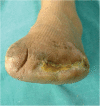VAC therapy to promote wound healing after surgical revascularisation for critical lower limb ischaemia
- PMID: 24872149
- PMCID: PMC7949501
- DOI: 10.1111/iwj.12301
VAC therapy to promote wound healing after surgical revascularisation for critical lower limb ischaemia
Abstract
Vacuum-assisted closure (VAC) therapy is a new emerging non-invasive system in wound care, which speeds up wound healing by causing vacuum, improving tissue perfusion and suctioning the exudates, and facilitating the removal of bacteria from the wound. The application of sub-atmospheric pressure on the lesions seems to alter the cytoskeleton of the cells on the wound bed, triggering a cascade of intracellular signals that increase the rate of cell division and subsequent formation of granulation tissue. The aim of this study is to analyse the results of VAC therapy used as an adjuvant therapy for the treatment of foot wounds in patients affected by critical limb ischaemia (CLI) (Rutherford 6 class) after distal surgical revascularisation, to promote and accelerate the healing of ulcers. Twenty-nine patients (20 males, 9 females; mean age 68·4) affected by CLI of Rutherford 6 class, after surgical revascularisation of the lower limb, underwent VAC therapy in order to speed up wound healing. Complete wound healing was achieved in 19 patients (65·51%), in an average period of 45·4 ± 25·6 days. VAC therapy is a valid aid, after surgical revascularisation, to achieve rapid healing of foot lesions in patients with CLI.
Keywords: Critical lower limb ischaemia; Vacuum-assisted closure therapy; Wound healing.
© 2014 The Authors. International Wound Journal © 2014 Medicalhelplines.com Inc and John Wiley & Sons Ltd.
Figures
References
-
- Wound Ostomy and Continence Nurses Society . Guideline for management of wounds in patients with lower‐extremity arterial disease. Glenview: Wound Ostomy and Continence Nurses Society, 2002. - PubMed
-
- Veves A, Falanga V, Armstrong DA, Sabolinski ML. Graftskin, a human skin equivalent, is effective in the management of noninfected neuropathic diabetic foot ulcers: a prospective randomized multicenter clinical trial. Diabetes Care 2001;24:2001–295. - PubMed
MeSH terms
LinkOut - more resources
Full Text Sources
Other Literature Sources
Research Materials
Miscellaneous




